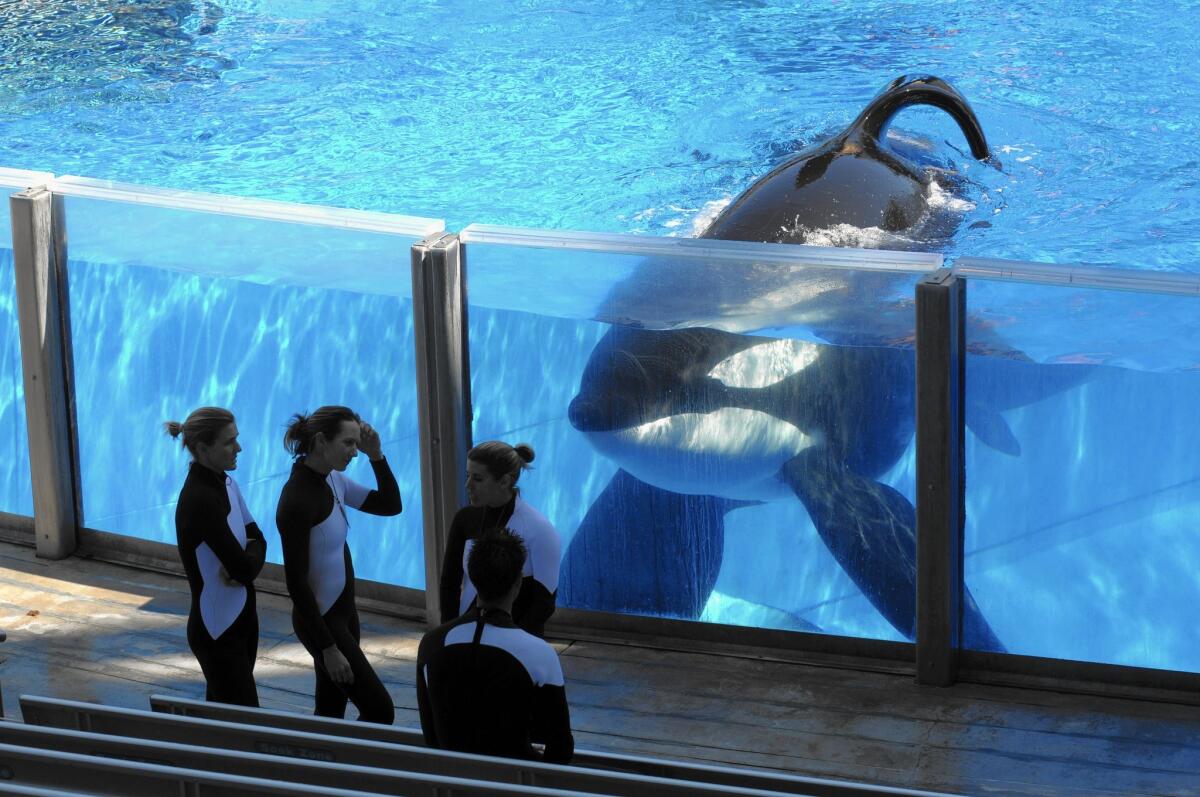Think SeaWorld’s turnaround satisfied animal-rights activists? Think again

SeaWorld Entertainment won the praises of animal rights activists last month when it made a surprising policy reversal and agreed to end the breeding program for its captive killer whales.
But don’t think that the change of heart sparked warm relations between the Orlando, Fla.-based theme park operator and animal rights advocates.
Animal rights groups have instead continued to press for even bigger changes at the company’s parks, including the release of SeaWorld’s 29 orcas to seaside sanctuaries and the end of breeding programs for all other captive animals.
The Humane Society of the United States, one of the nation’s largest animal rights organizations, met behind closed doors with SeaWorld executives to negotiate the end the breeding program. But even that group continues to put pressure for more changes.
“This is the beginning of discussions with SeaWorld, not the end,” said Wayne Pacelle, chief executive of the Humane Society, who wants to end the breeding of dolphins and other captive animals.
SeaWorld remains under fire, experts say, because of a shift in public opinion about the display of animals for entertainment, especially among millennials. That means growing criticism by animal rights group is now the price of doing business for marine theme parks, circuses and other operations that keep animals captive.
“PETA and other groups are not going to stop,” said Janet Davis, a history professor at the University of Texas at Austin and expert on popular culture, referring to People for the Ethical Treatment of Animals. “They see this as an opening to call for more dramatic changes.”
Now SeaWorld must figure out how to promote its animal rescue efforts and educational programs — more akin to the role of traditional aquariums — while offering entertainment that will draw in older fans of the traditional Shamu whale shows.
In an interview, SeaWorld Entertainment Chief Executive Joel Manby said that he never expected his private meetings with the Humane Society and his decision to ending the breeding program would win the endorsement of all animal rights groups because some activists will never be content with a business that keeps animals in captivity.
But he was optimistic that it would allow the company to move beyond the divisive debate and focus on a side of the business that could draw wide support, including from “millennial families”: rescuing injured and endangered animals.
“Some people love SeaWorld and some people will never like us,” he said. “We are focused on the mass middle of society.”
The chief executive said he realized that the change in attitude about animals was widespread after speaking to representatives for the Ringling Bros. and other companies that were under fire by activists prior to his decision to end the orca breeding program.
Some people love SeaWorld and some people will never like us. We are focused on the mass middle of society.
— SeaWorld Entertainment Chief Executive Joel Manby
After 144 years of displaying elephants, the parent company of Ringling Bros. and Barnum & Bailey Circus announced plans last year to end elephant performances and retire the animals to a sanctuary.
PETA praised the announcement but called for the circus to put an end to all animal acts.
“There has always been some constituency that is pushing,” Manby said.
The most ardent activists want SeaWorld to free its whales, dolphins and walruses and replace them with 3-D, virtual-reality versions that visitors can watch in giant theater screens.
But theme park experts say SeaWorld cannot survive as a modified aquarium or a virtual-reality whale exhibit.
“It doesn’t make sense,” Dennis Speigel, president of International Theme Park Services in Cincinnati, who noted that tourists can already see virtual-reality attractions at theme parks like Disneyland and Six Flags Magic Mountain.
The troubles for SeaWorld began in 2013 with the release of the documentary “Blackfish,” which accused the company of neglecting and abusing its killer whales. The film put the park squarely in the sights of animal activists.
At first, SeaWorld tried to repair its tarnished image by announcing plans to replace its theatrical orca shows with exhibits that highlight the whales’ natural behaviors. The company also introduced a $100-million plan to dramatically expand the habitat for the orcas in San Diego and hired Manby, a reform-minded former head of a large family-owned theme park.
But the changes did little to appease animal rights advocates. Sympathetic state and federal lawmakers jumped into the debate, proposing legislation to put an end to the whale breeding program. The California Coastal Commission approved the plans for a larger habitat in the San Diego park but only on the condition that the park stop breeding orcas.
After meeting privately with Pacelle from the Humane Society, Manby in March announced an end to the orca breeding program, saying the current whales will be the last generation in captivity. SeaWorld also canceled its $100-million expansion plan.
The controversy has led to a sharp decline in SeaWorld’s attendance and stock price. And so far the move by SeaWorld to end its orca breeding program hasn’t convinced Wall Street that a rebound is around the corner.
Michael Erstad, an analyst with ITG Investment, said in a memo to investors that he waiting to see if the decision improves the company’s performance.
“While management’s internal projections for improvement to operations from phasing out orca performances were encouraging, we would like to see more consistent trends before being constructive on the company’s efforts to stabilize and turn around the business,” he said.
Indeed, PETA has continued to lead protest in front of the parks. The group has called on SeaWorld to use the $100 million it set aside for the expansion project to build seaside sanctuaries that can house the orcas.
And once SeaWorld has released all of its killer whales to the ocean pens, the animal rights group says its wants SeaWorld to do the same for its captive dolphins, beluga whales and walruses.
“There is no doubt that all marine mammals bred in SeaWorld for entertainment are suffering,” said Heather Rally, a wildlife veterinarian with PETA.
Marine mammal experts disagree on whether such enclosures are safe for killer whales that are accustomed to human care.
Manby said SeaWorld won’t release any animal to the wild if such a move threatens the health of the animals. He noted that sea pens could costs millions of dollars to build and staff — money that he said could be better spent to help protect endangered animals in the wild.
“I don’t understand the lack of perspective on these issues,” Manby said.
The company already has begun work on protecting endangered animals, teaming up with the Humane Society to buy ads in several major newspapers, calling for the end of commercial whaling. But Pacelle said that won’t stop his group from pushing for the end of breeding for all captive animals.
“We want to be a problem solver for animal welfare, but we haven’t changed one policy position,” Pacelle said.
A handful of activists give SeaWorld more praise for the decision and suggest that SeaWorld will make more concessions through negotiations, not protests.
John Hargrove, a former orca trainer at SeaWorld who has advocated for the end of the killer whale breeding program, said animal rights groups need to recognize how much progress they have made with SeaWorld.
“If nothing else happens from this point forward, we won, meaning the whales won,” Hargrove said.
Twitter: @hugomartin
ALSO
Feds investigating payment service Venmo for possible deceptive practices
The plan: A rooftop solar project that can power 5,000 homes -- and 500 L.A. jobs
More to Read
Inside the business of entertainment
The Wide Shot brings you news, analysis and insights on everything from streaming wars to production — and what it all means for the future.
You may occasionally receive promotional content from the Los Angeles Times.










